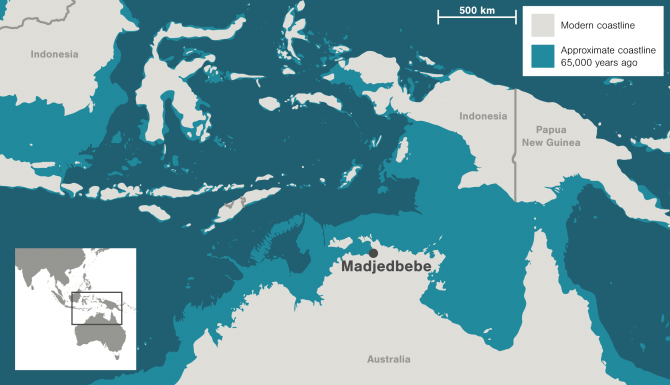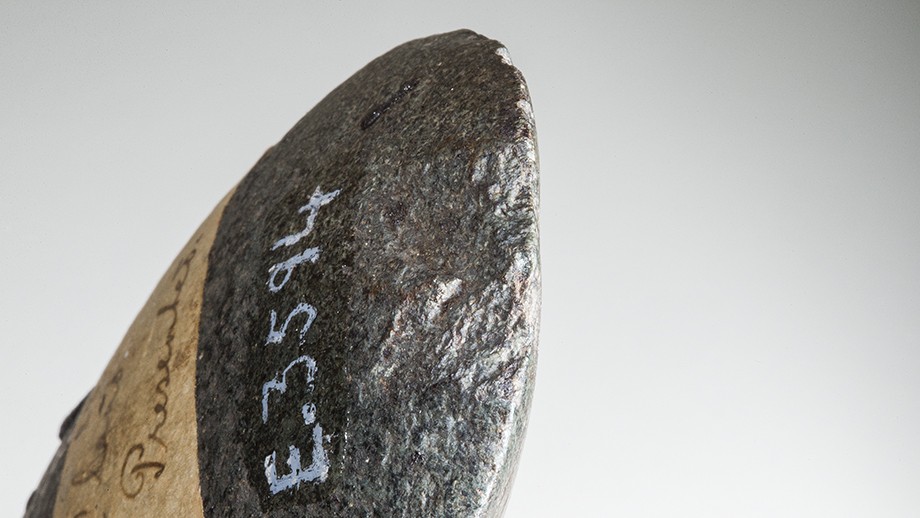At https://phys.org/print419665468.html … archeologists have placed humans arriving in Australia further and further back in time, throwing into confusion the Out of Africa theory (a migration out of Africa around 50,000 years ago. They have been forced to backtrack on this and now think Out of Africa occurred around 70,000 years ago. However, new evidence from Australia throws a spanner into this idea too and a migration as long ago as 200,000 years is being touted by some, admittedly on the fringe of the theory and taking it to the extreme. However, we may note if the latter figure is nearer reality and then they would have had plenty of time to reach Australia as the link above has produced evidence that Aboriginals were in a part of the northern territory 65,000 years ago. This means humans were also in New Guinea at the same time as it was attached to mainland Australia during the Late Pleistocene. What evidence has been lost as a result of sea level change and the submergence of a vast continental shelf system?
 A paper published in Nature (July 20th 2017) describes the dating techniques involved, which are somewhat controversial – mainly because some archaeologists and anthropologists do not like the implications. That is not to dismiss them out of hand as the dating process is novel. We may also note the new dates are welcome by other archaeologists and anthropologists as it removes the Aboriginals from blame for the mass die off of megafauna in Australia around 40 to 30,000 years ago. Giant kangaroos, Giant Wombats and Giant Tortoise died out in a mysterious manner that probably has all to do with a catastrophe at that time. The article says 45,000 years ago but that is the latest possible date for the die-off. We may note that Aboriginals themselves would have been part of the die-off.
A paper published in Nature (July 20th 2017) describes the dating techniques involved, which are somewhat controversial – mainly because some archaeologists and anthropologists do not like the implications. That is not to dismiss them out of hand as the dating process is novel. We may also note the new dates are welcome by other archaeologists and anthropologists as it removes the Aboriginals from blame for the mass die off of megafauna in Australia around 40 to 30,000 years ago. Giant kangaroos, Giant Wombats and Giant Tortoise died out in a mysterious manner that probably has all to do with a catastrophe at that time. The article says 45,000 years ago but that is the latest possible date for the die-off. We may note that Aboriginals themselves would have been part of the die-off.
The same story is at www.hakaimagazine.com/article-short/reimagining-history-human-migration-… …. with the title 'Re-imagining the History of Human Migration' by Zach Zorich. We learn these early Aboriginals ground nuts, gathered plants and seeds, built hearths and they also worked with grounded edged axes (unlike other humans who flaked stone) …
 … and used reflective pigments (catching the light in an unusual way). In recent years, he says, the picture of early human history has become ever more complex. In other words, the Out of Africa theory was found wanting has been forced to adapt to new findings and new dates. Scientific evidence, he claims, suggests modern humans first reached Europe around 40,000 years ago (or a little earlier). Prior to that Neanderthals lived in Europe and western Asia. Yet, Aboriginals have been living in Australia since at least 65,000 years ago (and probably longer). Excavations at Madjedbebe have been going on intermittently since the 1970s and have always been controversial, basically because they had to be force fitted into the Out of Africa framework. Out of Africa is sounding more and more like the Clovis First paradigm with one faction still clinging to the old ideas and others keen to puncture the barrier falsely erected by an older generation of researchers. Zorich claims DNA suggests Aborigines arrived 47,000 years ago – without looking into the nature of the die off event and the likelihood of a human bottleneck (in Australia as in other parts of the world). DNA research may have met its match if it cannot cope with bottlenecks. How useful is it as there may have been bottlenecks even after 40,000 years ago – at the end of the Ice Age, for example. The calculations of generations backwards are based on uniformitarian parameters. There is no reason why Aboriginals were not living in Australia and New Guinea prior to 65,000 years ago. Sea levels were quite different – see the image above and the position of Madjedbebe.
… and used reflective pigments (catching the light in an unusual way). In recent years, he says, the picture of early human history has become ever more complex. In other words, the Out of Africa theory was found wanting has been forced to adapt to new findings and new dates. Scientific evidence, he claims, suggests modern humans first reached Europe around 40,000 years ago (or a little earlier). Prior to that Neanderthals lived in Europe and western Asia. Yet, Aboriginals have been living in Australia since at least 65,000 years ago (and probably longer). Excavations at Madjedbebe have been going on intermittently since the 1970s and have always been controversial, basically because they had to be force fitted into the Out of Africa framework. Out of Africa is sounding more and more like the Clovis First paradigm with one faction still clinging to the old ideas and others keen to puncture the barrier falsely erected by an older generation of researchers. Zorich claims DNA suggests Aborigines arrived 47,000 years ago – without looking into the nature of the die off event and the likelihood of a human bottleneck (in Australia as in other parts of the world). DNA research may have met its match if it cannot cope with bottlenecks. How useful is it as there may have been bottlenecks even after 40,000 years ago – at the end of the Ice Age, for example. The calculations of generations backwards are based on uniformitarian parameters. There is no reason why Aboriginals were not living in Australia and New Guinea prior to 65,000 years ago. Sea levels were quite different – see the image above and the position of Madjedbebe.
